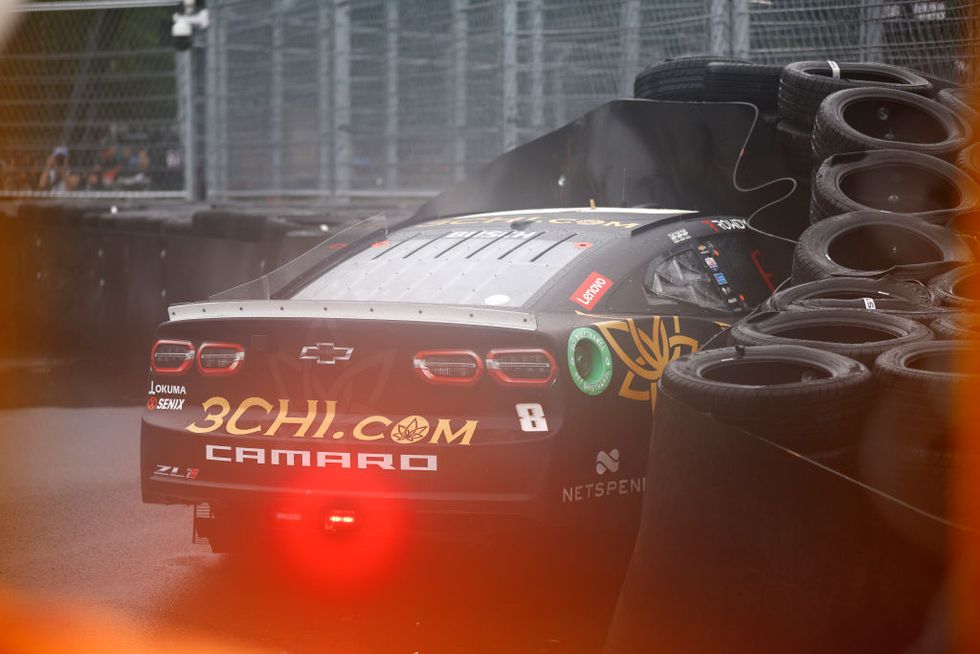- NASCAR fans saw mostly tedious, single-file, conservative riding in the Grant Park 220 on the streets of Chicago, punctuated every few laps by someone plowing into a tire barrier.
- Even when conditions improved and the circuit dried, the actual racing didn’t get much better.
- Still, despite everything that went wrong (rain, canceled concerts downtown), the first street “event” in NASCAR’s 75-year history was a rousing success.
I don’t get to make the call and neither do you. But if I did, I’d almost certainly give NASCAR a mulligan on last weekend’s Grant Park 220 Cup Series race. I’d gladly invite the good ol’ boys back to tee it up again during next year’s Thursday, July 4 week.
By almost any measure, the lap-by-lap racing on the Chicago Street Circuit was lacking. Stock car purists hoping for close, spirited competition were largely disappointed. Instead, they saw mostly tedious, single-file, conservative riding, punctuated every few laps by someone plowing into a tire barrier. (Here’s to you, Noah Gragson). Blame much of that on the weather, which left the 2.2-mile, 12-turn circuit sopping wet, then damp, then relatively dry toward the end.
But even when conditions improved and the circuit dried, the actual racing didn’t get much better. Only five drivers led, including rookie Ty Gibbs, who led one lap when everyone else was pitting. Combined, Tyler Reddick, Christopher Bell, and Justin Haley led all but 18 of the 78 laps; pole-winner Denny Hamlin didn’t lead even one. Race winner Shane Van Gisbergen, a NASCAR newbie from New Zealand driving a one-off for Trackside Racing’s Project 91, led lap 25 during pit cycles, then the final eight after easily passing Haley. It was the race’s fourth and final green-flag pass for the lead.
And it would be easier to list those who DID NOT crash than those who did. Even running 22 laps fewer than the scheduled 100, the race was slowed by nine yellow flags for 21 laps. There were a handful of other incidents that probably warranted the caution, but didn’t get it because the driver(s) escaped the tire walls and drove away. Granted, most of those incidents were dampness-related, perhaps understandable because Cup drivers are unaccustomed to enduring such damp-to-dry conditions.
As you would expect—because that’s what they do—NASCAR executives were upbeat and said all the right things.
“I think our drivers performed incredibly today,” chief operating officer Steve O’Donnell said afterward. “(It was) one of the best events I’ve seen.” Ben Kennedy, the driving force behind the event and vice president of Racing Development, was more complimentary of the city. “I certainly think it was a remarkable weekend, a historic weekend for us,” the great grandson of NASCAR founder Bill France said. “A huge thank you to the city of Chicago. The city showed up so well today from the backdrop on NBC to the energy among the fans and the crowds. It was certainly remarkable.”
Understandably—and regrettably so because so much time and money and effort went into the historic project—weather killed the crowds. The weekend’s record rainfall was the first in the area in a month. (Need rain? Schedule a NASCAR race). Several concerts expected to lure thousands of 20-somethings to the venue were canceled. The Saturday afternoon Xfinity Series race was stopped short of halfway and rescheduled for Sunday morning. When rain persisted, it was declared official with pole-winner Cole Custer leading all 25 of the scheduled 56 laps.
Still, despite everything that went wrong, the first street “event” in NASCAR’s 75-year history was a rousing success. On-site observers said the crucial “festival/party vibe” was in the air all weekend. Teams and city officials reportedly were optimistic and patient and confident even as conditions were miserable. Curious onlookers without tickets pressed against fencing, hoping to get a look at what was going on. For once, the city’s appalling gun-violence statistics weren’t mentioned.
NASCAR should try the downtown street racing thing gain because … well, because it can. (Chicago and NASCAR have a three-year contract, but either side can opt out). Maybe it will be Chicago again, after adding passing zones and widening some of those 90-degree turns. Or, if not there, haul those concrete barriers and tire walls and fencing and portable grandstands to another major American city that would welcome a NASCAR presence. New Orleans? Denver? Seattle? Minneapolis? New Yor….. oh, never mind that one.
In summary: what teams, officials, NASCAR leadership, and Chicago organizers pulled off was truly remarkable. They got it done at a time when humiliating failure was just another downpour away. It’s hard to imagine overcoming a situation as bleak as the one they faced mid-afternoon Sunday.
For that reason alone, they should get a mulligan.
Contributing Editor
Unemployed after three years as an Army officer and Vietnam vet, Al Pearce shamelessly lied his way onto a small newspaper’s sports staff in Virginia in 1969. He inherited motorsports, a strange and unfamiliar beat which quickly became an obsession.
In 53 years – 48 ongoing with Autoweek – there have been thousands of NASCAR, NHRA, IMSA, and APBA assignments on weekend tracks and major venues like Daytona Beach, Indianapolis, LeMans, and Watkins Glen. The job – and accompanying benefits – has taken him to all 50 states and more than a dozen countries.
He’s been fortunate enough to attract interest from several publishers, thus his 13 motorsports-related books. He can change a tire on his Hyundai, but that’s about it.
Read the full article here




